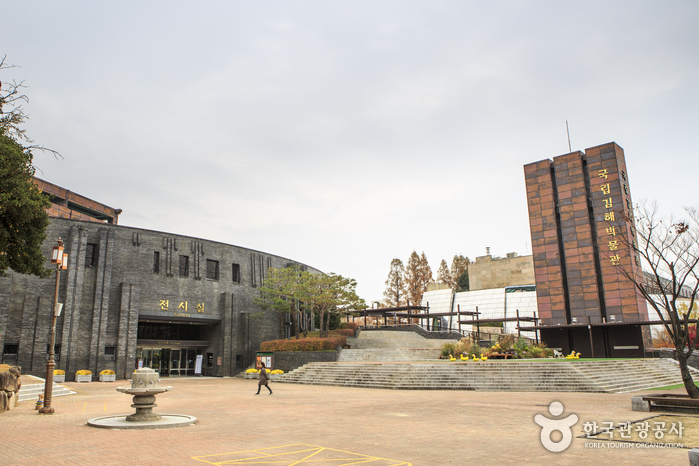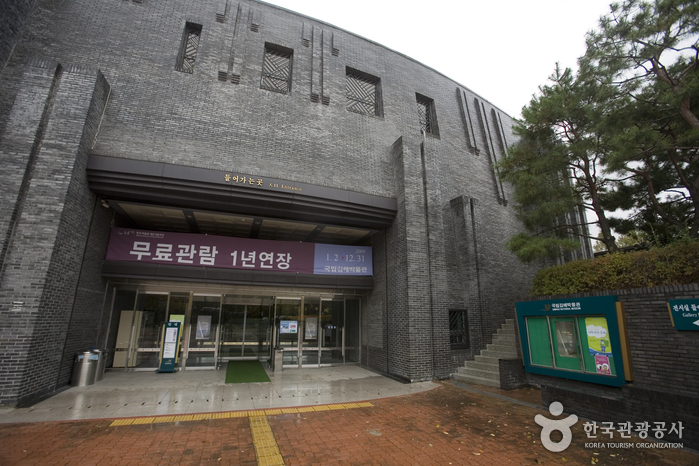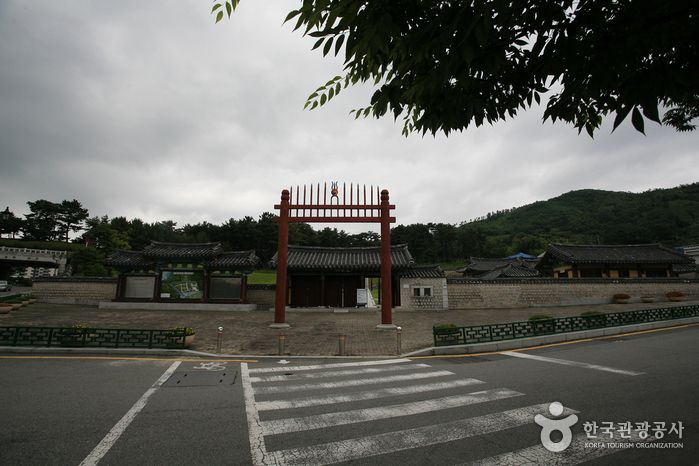Gimhae National Museum (국립김해박물관)
1.5Km 2024-01-23
190 Gayaui-gil, Gimhae-si, Gyeongsangnam-do
The Gimhae National Museum was opened on July 29, 1998, in order to research and preserve the cultural heritage of the ancient kingdom of Gaya. The museum is at the foot of Gujibong Peak in Gimhae-si, the spot where the kingdom is believed to have been founded. The museum exhibits the cultural assets of Gaya, as well as cultural relics from the prehistoric age in the Busan and Gyeongsangnam-do areas, and the cultural heritage of Byeonhan, which was the foundation for the growth of Gaya.
The exterior of the museum is made using black bricks representing iron ore and charcoal famous during the Gaya Kingdom. There are two exhibition halls, while the walkway to the halls have approximately 1,300 artifacts in display.
Seollal Traditional & Cultural Event of Gimhae National Museum (국립김해박물관 설맞이 전통문화행사)
1.5Km 2020-03-21
190, Gayaui-gil, Gimhae-si, Gyeongsangnam-do
• 1330 Travel Hotline: +82-2-1330
(Korean, English, Japanese, Chinese) • For more info: +82-55-320-6821
To greet Seollal, one of the biggest national holidays in Korea, Gimhae National Museum hosts a “Seollal Traditional & Cultural Event.” During the event, visitors can take part in traditional activities and view regional cultural assets.
Tomb of Queen Consort of King Suro (김해 수로왕비릉)
1.6Km 2020-04-04
1, Garak-ro 190beon-gil, Gimhae-si, Gyeongsangnam-do
+82-55-338-1330
Tomb of Queen Consort of King Suro in Gusan-dong, Gimhae is the final resting place of Queen Heo, the Queen Consort of King Suro, the founder of Garak. The tomb dates all the way back to the Gaya dynasty and has been officially designated as Historic Site No. 74. Unlike many other ancient tomb mounds that are raised on flat land, Queen Heo's mound sits high upon a hill. In front of the tomb is Pasa Stone Pagoda, which its stones are known to have come from India.
Together with the Tomb of King Suro, the tomb preservation area was expanded in the 28th year of King Sejong’s reign (1446). Records indicate that the tombs were robbed over a century later during the Imjin War (1592-1598). The current headstone and plaque by the tomb was installed in the Joseon dynasty in the 25th year of King Injo's reign (1641).
Culture City of East Asia Gimhae (동아시아문화도시 김해)
1.6Km 2024-10-18
2060 Gimhae-daero, Gimhae-si, Gyeongsangnam-do
+82-51-781-2437
The Culture City of East Asia is an agreement to promote diverse cultural exchanges between Korea, China, and Japan. Under the value of respect for cultural diversity among Korea, China, and Japan, each year one city from each country is designated as a “Culture City of East Asia” to practice the spirit of “East Asian consciousness, cultural exchange and convergence, and understanding of other cultures.” (Source: Culture City of East Asia website)
Gimhae Arts and Sports Center (김해문화의전당)
1.6Km 2022-12-29
2060, Gimhae-daero, Gimhae-si, Gyeongsangnam-do
+82-55-320-1234
The Gimhae Arts and Sports Center is a performance hall for high-class performances. Maru Hall is a multi-purpose theater that also contains a moving orchestra shell with a sound reflection board for a smaller concert hall inside the theater. Nuri Hall is an experimental theater for performances in a variety of themes. The center also features the outdoor theater Aedureum Madang, Yunseul Art Gallery, Media Center, Sports Center, and Aram Learning Center, as well as a café and restaurants.
Mega Mart - Gimhae Branch [Tax Refund Shop] (메가마트 김해점)
2.6Km 2024-04-22
20, Gimhae-daero 2492beon-gil, Gimhae-si, Gyeongsangnam-do
-
Bunsanseong Fortress (김해 분산성)
2.6Km 2023-01-18
210-162, Gaya-ro 405beon-gil, Gimhae-si, Gyeongsangnam-do
+82-55-330-3925
Bunsanseong Fortress was constructed in the 3rd year of the reign of Goryeo's King U (1377) by Magistrate Park Wi to defend against foreign enemies, but it was destroyed during the Japanese invasion of 1592. The fortress we see today was reconstructed by Magistrate Jeong Hyeon-seok in the 8th year of the reign of Joseon's King Gojong (1871). However, it is estimated that it was first built during the days of Gaya. It is a temoe-style fortress with rocks piled up like a long band at the peak of Bunsan from which downtown Gimhae, Gimhae Plains, the Nakdonggang River and the South Sea are all in a single, panoramic view. Today, fortress walls remain stretching for some 900 meters on the slope towards the city and, inside the fortress, there are two gate sites in the south and north, an auxiliary gate on the west, a well site and several other building sites. The exact length of the remaining fortress walls is 929 meters and the average x_width is about 8 meters.
Inside the fortress lies Haeeunsa Temple, which was built to pay respects to Queen Heo of Garak who had come from the sea, according to stories. The temple also enshrines portraits of King Suro and Queen Heo that were painted during the Joseon dynasty. During the Japanese invasion of 1592, monk soldiers were stationed at this temple.
The fortress is more popularly called "Manjangdae" by Gimhae locals, and this name originated from the description, "A tall tower 10,000 (man) gil in x_height," granted by Daewongun in the Joseon dynasty for this advanced base that defeats Japanese invaders. A writing of "Manjangdae" written by Daewongun himself as well as his stamp are engraved on a rock behind a beacon that was restored in 1999.
Gimhae Astronomical Observatory (김해천문대)
2.9Km 2022-12-29
254, Gaya thema-gil, Gimhae-si, Gyeongsangnam-do
+82-55-337-3785
Gimhae Astronomical Observatory opened on February 1, 2002 as part of the Millennium Commemorative Project that started in December 1998. It was built to satisfy the general public’s curiosity about the universe and celestial bodies, inspire young people, and give everyone a unique, memorable experience. The observatory is shaped like an egg, in memory of the legend of King Kim Suro, the founder of the Garak Kingdom, according to which the king was born from an egg.
It is said that the queen of King Suro, Heo Hwang-ok, was a princess from the Indian country of Ayuta. Since sophisticated navigation equipment had yet to be invented, it can be assumed that she found her way to the Garak Kingdom by following the stars. It is also said that a prince of the Garak Kingdom built an observatory on the highest point of a mud fortress in Jinrye in order to make astronomical observations. The place is still referred to as Bibidan, which means a place to watch the stars.
These historical facts indicate the stars were very important to the Gaya, an ancient kingdom established mainly in the Gimhae area. The peak of Bunseongsan Mountain, where the observatory is located, offers sweeping views of the entire area of Gimhae. The night sky of Gimhae offers a breathtaking sight.
Subaekdang Dwaejigukbap Gimhae Branch (수백당돼지국밥김해점)
3.0Km 2024-01-24
109 Inje-ro, Gimhae-si, Gyeongsangnam-do
Subaekdang Dwaejigukbap specializes in dwaeji gukbap (pork and rice soup) with boiled pork slices and rice in a broth simmered with pork bones. Its owner is said to have visited 96 pork soup restaurants across the country to study the taste and make the best pork and rice soup. The rich, refreshing broth made by boiling pork backbone for a long time is excellent. This restaurant also serves sundae gukbap (sundae and rice soup) made with premium Berkshire pork. The Maneul Suyuk Baekban (garlic and boiled pork slices set menu), one of its signature items, is made with pork belly that anyone loves and topped with garlic sauce.
Miryang Dwaeji Gukbap (밀양돼지국밥)
3.0Km 2024-02-23
91 Inje-ro, Gimhae-si, Gyeongsangnam-do
Miryang Dwaeji Gukbap is a renowned dwaeji gukbap (pork and rice soup) establishment located in Eobang-dong, Gimhae-si. Recognized among the top 100 recommended restaurants for Gimhae tourism by the city, this eatery has become so popular that visitors often queue to taste its offerings. Standard accompaniments include buchu muchim (chive salad), chili peppers, garlic, and kimchi. In addition to dwaeji gukbap, visitors can enjoy suyuk (boiled pork slices). Nearby attractions include Gimhae Gaya History Park, Gaya Land, and Bunseongsan Mountain.





![Mega Mart - Gimhae Branch [Tax Refund Shop] (메가마트 김해점)](http://tong.visitkorea.or.kr/cms/resource/29/2885929_image2_1.jpg)
 English
English
 한국어
한국어 日本語
日本語 中文(简体)
中文(简体) Deutsch
Deutsch Français
Français Español
Español Русский
Русский